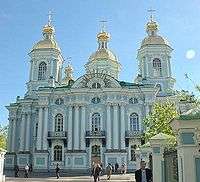List of modern great powers
A great power is a nation or state that, through its great economic, political and military strength, is able to exert power and influence not only over its own region of the world, but beyond to others.
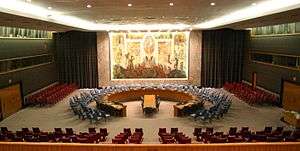
In a modern context, recognized great powers first arose in Europe during the post-Napoleonic era.[1] The formalization of the division between small powers[2] and great powers came about with the signing of the Treaty of Chaumont in 1814.
The historical terms "Great Nation",[3][4][5] a distinguished aggregate of people inhabiting a particular country or territory, and "Great Empire",[6] a considerable group of states or countries under a single supreme authority, are colloquial; their use is seen in ordinary historical conversations.
Early modern powers
- 1492–1815
- Early Modern history
France
- 1450s–1815
| French colonial empire |
|---|
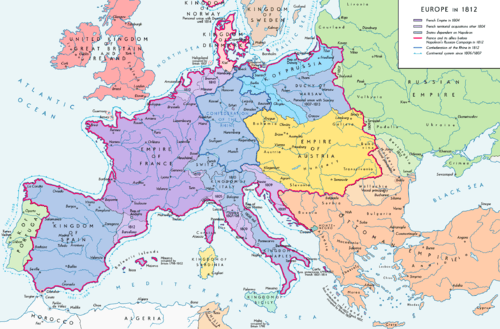 The French Empire in 1812. |

Map of the first (green) and second (dark blue — plain and hachured) French colonial empires.
|
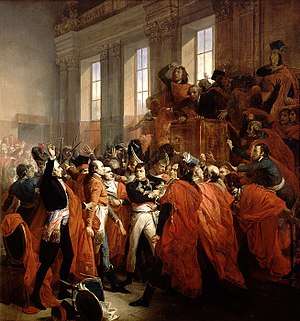
France was a dominant empire possessing many colonies in various locations around the world. During Louis XIV's long reign, from 1643 to 1715, France was the leading European power. The Empire of the French (1804–1814), also known as the Greater French Empire or First French Empire, but more commonly known as the Napoleonic Empire, was also the dominant power of much of continental Europe during the early 19th Century.
Napoleon became Emperor of the French (French: L'Empereur des Français) on 18 May 1804 and crowned Emperor 2 December 1804, ending the period of the French Consulate, and won early military victories in the War of the Third Coalition against Austria, Prussia, Russia, Portugal, and allied nations, notably at the Battle of Austerlitz (1805) and the Battle of Friedland (1807). The Treaty of Tilsit in July 1807 ended two years of bloodshed on the European continent. Subsequent years of military victories known collectively as the Napoleonic Wars extended French influence over much of Western Europe and into Poland. At its height in 1812, the French Empire had 130 départements, ruled over 70 million subjects, maintained extensive military presence in Germany, Italy, Spain, and the Duchy of Warsaw, and could count Prussia, Russia and Austria as nominal allies.
Early French victories exported many ideological features of the French Revolution throughout Europe. Napoleon gained support by appealing to some common concerns of the people. In France, these included fear by some of a restoration of the ancien régime, a dislike of the Bourbons and the emigrant nobility who had escaped the country, a suspicion of foreign kings who had tried to reverse the Revolution – and a wish by Jacobins to extend France's revolutionary ideals.
The feudal system was abolished, aristocratic privileges were eliminated in all places except Poland, and the introduction of the Napoleonic Code throughout the continent increased legal equality, established jury systems, and legalized divorce. Napoleon placed relatives on the thrones of several European countries and granted many titles, most of which expired with the fall of the Empire. Napoleon wished to make an alliance with South India Mysore ruler Tipu Sultan and provide them French-trained army during the Anglo-Mysore Wars, with the continuous aim of having an eventual open way to attack the British in India.[7][8]
Historians have estimated the death toll from the Napoleonic Wars to be 6.5 million people, or 15% of the French Empire's subjects. The War of the Sixth Coalition, a coalition of Austria, Prussia, Russia, the United Kingdom, Sweden, Spain and a number of German States finally defeated France and drove Napoleon Bonaparte into exile on Elba. After Napoleon's disastrous invasion of Russia, the continental powers joined Russia, Britain, Portugal and the rebels in Spain. With their armies reorganized, they drove Napoleon out of Germany in 1813 and invaded France in 1814, forcing Napoleon to abdicate and restoring the Bourbons.
Papacy

- 1420–1648
The Papacy was considered one of the great powers of the age by important thinkers such as Machiavelli and Giovanni Botero. The Papal States covered central Italy and were expanded by warrior popes such as Julius II. Italy, although divided in several states, saw a period of great prosperity during the Renaissance. In 1420, Pope Martin V re-established Rome as the sole seat of the Catholic Church and put an end to the Western Schism. Between 1494 and the second half of the 16th century, Italy was the battleground of Europe. Competing monarchs, including Popes, clashed for European supremacy in Italy. In the late 1500s and early 1600s, the Papacy led the Counter-reformation effort. Pontiffs such as Paul III and Pius V, exercised great diplomatic influence in Europe. Popes mediated the Peace of Nice (1538) between the Holy Roman Empire and France, as well as the Peace of Vervins (1598) between France and Spain. In the new world, thousands were converted to Catholicism by missionaries. Many European and Italian states (such as the Republic of Venice and the Republic of Genoa) were brought by the Papacy into "Holy Leagues" to defeat the Ottoman Empire: defeats occurred in Rhodes (1522), Preveza (1538), Budapes (1541), Algiers (1541), whereas victories took place at Vienna (1529), Tunis (1535), Lepanto (1571), and Malta (1565). Similarly, the Church supported catholic leagues in the European wars of religion fought in France, the Low Countries, and Germany. France remained catholic following the conversion of the French king, whereas half of the Low Countries were lost to Protestantism. It was the 30 years war that ultimately ended the status of the Papacy as a great power. Although the Pope declared Westphalia "null and void", European rulers refused to obey Papal orders and even rejected Papal mediation at the negotiations of the treaty.
Qing Dynasty
- 1660s – 1900s
| Qing Dynasty |
|---|

Qing Dynasty in 1820.
|
The Qing dynasty was the last ruling dynasty of China, established in 1636 and collapsed in 1912 (with a brief, abortive restoration in 1917). It was preceded by the Ming dynasty and followed by the Republic of China. The dynasty was founded by the Manchu clan Aisin Gioro in what is today Northeast China (also known as "Manchuria"). Starting in 1644, it expanded into China proper and its surrounding territories, establishing the Empire of the Great Qing. Complete pacification of China was accomplished around 1683 under the Kangxi Emperor.
Originally the Later Jin dynasty, the dynasty changed its name to "Great Qing", meaning "clear" or "pellucid", in 1636. In 1644, Beijing was sacked by a coalition of rebel forces led by Li Zicheng, a minor Ming official who later proclaimed the Shun dynasty. The last Ming emperor, the Chongzhen Emperor, committed suicide when the city fell, marking the official end of the Ming dynasty. The Manchus then allied with Ming general Wu Sangui and seized control of Beijing and overthrew Li's short-lived Shun dynasty.[9] The Qing dynasty became highly Sinicized. The dynasty reached its height in the 18th century during the reign of the Qianlong Emperor, during which both its territory and population greatly expanded. However, its military power weakened hereafter and faced with massive rebellions and defeats in wars, the Qing dynasty declined after the mid-19th century. The Qing dynasty was overthrown following the Xinhai Revolution.[10]
Iran
Safavid Empire
- 1501–1736
| Safavid dynasty |
|---|
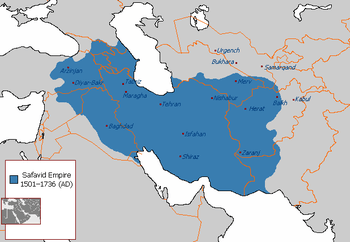 The Safavid Empire at its greatest extent. |
The Safavid Empire was one of the most significant ruling dynasties of Iran. They ruled one of the greatest Iranian Empires after the Muslim conquest of Persia[11][12][13][14] The Safavids ruled from 1501 to 1736 and at their height, they controlled all of modern Iran, Azerbaijan and Armenia, most of Iraq, Georgia, Afghanistan, and the Caucasus, as well as parts of Pakistan, Turkmenistan and Turkey. Safavid Iran was one of the Islamic "gunpowder empires". The Safavid empire originated from Ardabil in Iran and had its origins in a long established Sufi order, called the Safaviyeh. The Safavids established an independent unified Iranian state for the first time after the Muslim conquest of Persia and reasserted Iranian political identity, and established Shia Islam as the official religion in Iran.
Despite their demise in 1736, the legacy that they left behind was the revival of Iran as an economic stronghold between East and West, the establishment of an efficient state and bureaucracy based upon "checks and balances", their architectural innovations and their patronage for fine arts. The Safavids have also left their mark down to the present era by spreading Shi'a Islam in Iran, as well as major parts of the Caucasus, Mesopotamia, and Anatolia.
Afsharid Empire
| Afsharid dynasty |
|---|
The Afsharid dynasty was an Iranian dynasty that originated from the Afshar tribe in Iran's north-eastern province of Khorasan, ruling Iran in the mid-eighteenth century. The dynasty was founded in 1736 by the military genius Nader Shah,[15] who deposed the last member of the Safavid dynasty and proclaimed himself as the Shah of Iran. At its peak, the empire was arguably the most powerful in the world.[16] During Nader's reign, Iran reached its greatest extent since the Sasanian Empire. At its height it controlled modern-day Iran, Armenia, Georgia, Azerbaijan Republic, parts of the North Caucasus (Dagestan), Afghanistan, Bahrain, Turkmenistan, Uzbekistan and Pakistan, and parts of Iraq, Turkey, United Arab Emirates and Oman.
Dutch Republic
- 1581–1795
| Dutch Empire |
|---|
A map showing the territory that the Netherlands held at various points in history. Dark green indicates colonies that either were, or originated from, land controlled by the Dutch West India Company, light green the Dutch East India Company. In yellow the territories occupied later, during the 19th century.
|
The Dutch Republic controlled various territories after the Dutch achieved independence from Spain in the 16th century. Their skills in shipping and trading aided the building of an overseas colonial empire which lasted from the 16th to the 20th century. The Dutch initially built up colonial possessions on the basis of indirect state capitalist corporate colonialism, with the dominant Dutch East India Company. A cultural flowering roughly spanning the 17th century is known as the Dutch Golden Age, in which Dutch trade, science and art were among the most acclaimed in the world. Dutch military power was at its height in the middle of the 17th century and in that era the Dutch navy was the most powerful navy in the world.[17]
By the middle of the 17th century, the Dutch had overtaken Portugal as the dominant player in the spice and silk trade, and in 1652 founded a colony at Cape Town on the coast of South Africa, as a way-station for its ships on the route between Europe and Asia. After the first settlers spread out around the Company station, nomadic white livestock farmers, or Trekboers, moved more widely afield, leaving the richer, but limited, farming lands of the coast for the drier interior tableland. Between 1602 and 1796, million Europeans were sent to work in the Asia trade. The majority died of disease or made their way back to Europe, but some of them made the Indies their new home. Interaction between the Dutch and native population mainly took place in Sri Lanka and the modern Indonesian Islands. Through the centuries there developed a relatively large Dutch-speaking population of mixed Dutch and Indonesian descent, known as Indos or Dutch-Indonesians.
First British Empire
- 1600–1815
| British Empire |
|---|

The territories that were at one time or another part of the British Empire.
|
|
The First British empire began in the 17th century as a combination of factors led to its creation, such as the growth in British trade with Mughal India, the success of the British East India Company, numerous British maritime explorations around the world, and the vast Royal Navy. The British Empire comprised the dominions, colonies, protectorates, mandates, and other territories ruled or administered by the United Kingdom. It originated with the overseas colonies and trading posts established by England in the late 16th and early 17th centuries.[18]
British colonies were created along the east coast of North America during the 17th and 18th centuries but by the late 18th century 13 of these colonies rebelled in the American War of Independence (1775-1783) and formed the United States of America. The Second British Empire was built primarily in Asia, the Middle East and Africa after 1800. It included colonies in Canada, the Caribbean and India, and shortly thereafter began the settlement of Australia and New Zealand. Following France's defeat in the Napoleonic Wars in 1815, Great Britain took possession of many more overseas territories in Africa and Asia, and established informal empires of free trade in South America,Persia etc.
At its height it was the largest empire in history and, for over a century, was the foremost global power. In 1815-1914 the Pax Britannica the Empire was the most powerful unitary authority in history due to the unprecedented level of naval predominance of the Royal Navy.[19]
Mughal India
- 1526–1857
| Mughal Empire |
|---|
 |
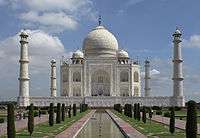
India's Mughal Empire was a Turkic-Mongol imperial power from Uzbekistan, that ruled most of the Indian subcontinent in 16th and 17th century.[21] In 1526, Babur, a Timurid descendant of Tamerlane and Genghis Khan from Fergana Valley in Uzbekistan, swept across the Khyber Pass and established the Mughal Empire, which lasted for over 300 years, ruling 1/4 of the world's population at a time.[22]
The Mughal Dynasty rapidly expanded and ruled most of the Indian subcontinent by 1600; it went into a slow decline after 1707 and was finally defeated during the 1857 War of Independence also called the Indian Rebellion of 1857. The famous emperor Akbar, who was the grandson of Babur, tried to establish an inclusive empire. However, later emperors such as Aurangzeb expanded the empire beyond its previous limitations through Islamic sharia. Under his reign Mughal India became the world's largest economy, worth 25% of world GDP,[23][24][25][26] and its wealthiest subdivision, the Bengal Subah, a long time major global nation, signaled the proto-industrialization and showed signs of the Industrial revolution.[27] His death marks the end of Medieval India and beginning of European conquests of India.
Ottoman Empire
- 1299–1923
| Ottoman Empire |
|---|

Ottoman territories at its greatest extent (See: list of territories).
|
|
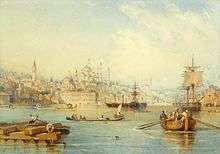
The Ottoman Empire was a Turkic state, which at the height of its power (16th–17th centuries) spanned three continents (see: extent of Ottoman territories) controlling parts of Southeastern Europe, the Middle East and most of North Africa.[28] The empire has been called by historians a "Universal Empire" due to both Roman and Islamic traditions.[29] It was the head of the Gunpowder Empires.
The empire was at the center of interactions between the Eastern and Western worlds for six centuries. The Ottoman Empire was the only Islamic power to seriously challenge the rising power of Western Europe between the 15th and 19th centuries. With Istanbul (or Constantinople) as its capital, the Empire was in some respects an Islamic successor of earlier Mediterranean empires—the Roman and Byzantine empires.
Ottoman military reform efforts begin with Selim III (1789–1807) who made the first major attempts to modernize the army along European lines. These efforts, however, were hampered by reactionary movements, partly from the religious leadership, but primarily from the Janissary corps, who had become anarchic and ineffectual. Jealous of their privileges and firmly opposed to change, they created a Janissary revolt. Selim's efforts cost him his throne and his life, but were resolved in spectacular and bloody fashion by his successor, the dynamic Mahmud II, who massacred the Janissary corps in 1826.
The effective military and bureaucratic structures of the previous century also came under strain during a protracted period of misrule by weak Sultans. But in spite of these difficulties, the Empire remained a major expansionist power until the Battle of Vienna in 1683, which marked the end of Ottoman expansion into Europe. Much of the decline took place in the 19th century under pressure from Russia. Egypt and the Balkans were lost by 1913, and the Empire disintegrated after the First World War, leaving Turkey as the successor state.[30]
Poland
Polish–Lithuanian Commonwealth (1569–1795)
| Polish–Lithuanian Commonwealth |
|---|
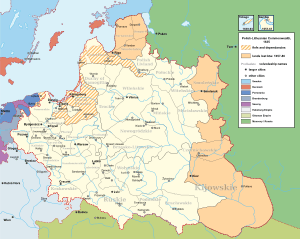 Polish–Lithuanian Commonwealth at its greatest extent (ca. 1635) |
The Polish-Lithuanian Commonwealth was one of the largest, most powerful and most populous[31] countries in 16th, 17th, and 18th century Europe. Its political structure was formed in 1569 by the Union of Lublin, which united the Kingdom of Poland and the Grand Duchy of Lithuania, and lasted in this form until the adoption of the Constitution of May 3, 1791. In the 16th century, the area of the Commonwealth reached almost 1 million km2., with a population of 11 million. Poland-Lithuania was a political, military and economic power.
The Union possessed features unique among contemporary states. This political system unusual for its time stemmed from the ascendance of the szlachta noble class over other social classes and over the political system of monarchy. In time, the szlachta accumulated enough privileges (such as those established by the Nihil novi Act of 1505) that no monarch could hope to break the szlachta's grip on power. The Commonwealth's political system is difficult to fit into a simple category, but it can be tentatively described as a mixture of:
- confederation and federation, with regard to the broad autonomy of its regions. It is, however, difficult to decisively call the Commonwealth either confederation or federation, as it had some qualities of both of them;
 Shuysky's tribute – homage of the deposed Tsar of Russia Vasyl IV Shuysky and his brothers Dmitri and Ivan before Polish King Sigismund III Vasa and prince Ladislaus in 1611, Warsaw.
Shuysky's tribute – homage of the deposed Tsar of Russia Vasyl IV Shuysky and his brothers Dmitri and Ivan before Polish King Sigismund III Vasa and prince Ladislaus in 1611, Warsaw. - oligarchy, as only the szlachta—around 9% of the population—had political rights;
- democracy, since all the szlachta were equal in rights and privileges, and the Sejm could veto the king on important matters, including legislation (the adoption of new laws), foreign affairs, declaration of war, and taxation (changes of existing taxes or the levying of new ones). Also, the 9% of Commonwealth population who enjoyed those political rights (the szlachta)[32] was a substantially larger percentage than in majority European countries;[33] note that in 1789 in France only about 1% of the population had the right to vote, and in 1867 in the United Kingdom, only about 3%.[32][33]
- elective monarchy, since the monarch, elected by the szlachta, was Head of State;
- constitutional monarchy, since the monarch was bound by pacta conventa and other laws, and the szlachta could disobey any king's decrees they deemed illegal.
The Polish "Golden Age", the period of the reigns of Sigismund I and Sigismund II, the last two Jagiellonian kings, or more generally the 16th century, is most often identified with the rise of the culture of Polish Renaissance. The cultural flowering had its material base in the prosperity of the elites, both the landed nobility and urban patriciate at such centers as Cracow and Danzig. After victories of Dimitriads (Battle of Klushino), Polish forces entering Moscow in 1610, Sigismund's III son, Prince Władysław of Poland, was briefly elected Tsar of Russia. However, soon afterwards, Sigismund III Vasa decided to seize the Russian throne for himself.
Portugal
- 1415–2002

| Portuguese Empire |
|---|

An anachronous map of the Portuguese Empire (1415–2002).
|
The Portuguese Empire was the first global empire in history, and also the earliest and longest-lived of the Western European colonial empires. Portugal's small size and population restricted the empire, in the 16th century, to a collection of small but well defended outposts along the African coasts, the main exceptions being Angola, Mozambique and Brazil. For most of the 16th century, the Portuguese Indian Armadas, then the world leader navy in shipbuilding and naval artillery, dominated most of the Atlantic Ocean south of the Canary Islands, the Indian Ocean and the access to the western Pacific. The height of the empire was reached in the 16th century but the indifference of the Habsburg kings and the competition with new colonial empires like the British, French and Dutch started its long and gradual decline. After the 18th century Portugal concentrated in the colonization of Brazil and African possessions.
The Treaty of Tordesillas, between Spain and Portugal, divided the world outside of Europe in an exclusive duopoly along a north–south meridian 370 leagues, or 970 miles (1,560 km), west of the Cape Verde islands. However, as it was not possible at the time to correctly measure longitude, the exact boundary was disputed by the two countries until 1777. The completion of these negotiations with Spain is one of several reasons proposed by historians for why it took nine years for the Portuguese to follow up on Dias's voyage to the Cape of Good Hope, though it has also been speculated that other voyages were in fact secretly taking place during that time. Whether or not this was the case, the long-standing Portuguese goal of finding a sea route to Asia was finally achieved in a ground-breaking voyage commanded by Vasco da Gama.
Prussia
- 1525–1871
The Kingdom of Prussia dominated northern Germany politically, economically, and in terms of population, and was the core of the unified North German Confederation formed in 1867. Prussia was by far the largest and most important component of the German Empire or Deutsches Reich formed in 1871.
Prussia attained its greatest importance in the 18th and 19th centuries. During the 18th century, it became a European great power under the reign of Frederick II of Prussia (1740–86). During the 19th century, Chancellor Otto von Bismarck pursued a policy of uniting the German principalities into a "Lesser Germany" which would exclude the Austrian Empire.
Spanish Empire
- 1492–1975
| Spanish Empire |
|---|
|
An anachronous map showing areas pertaining to the Spanish Empire at various times over a period exceeding 400 years.
|

Map of the territories come under the Spanish monarch during the Iberian Union.
|
|

In the 16th century Spain and Portugal were in the vanguard of European global exploration and colonial expansion and the opening of trade routes across the oceans, with trade flourishing across the Atlantic Ocean between Spain and the Americas and across the Pacific Ocean between Asia-Pacific and Mexico via the Philippines. Conquistadors toppled the Aztec, Inca, and Maya civilizations, and laid claim to vast stretches of land in North and South America. For a long time, the Spanish Empire dominated the oceans with its navy and ruled the European battlefield with its infantry, the famous tercios. Spain enjoyed a cultural golden age in the 16th and 17th centuries as Europe's foremost power.
From 1580 to 1640 the Spanish Empire and the Portuguese Empire were conjoined in a personal union of its Habsburg monarchs, during the period of the Iberian Union, though the empires continued to be administered separately.
From the middle of the 16th century silver and gold from the American mines increasingly financed the military capability of Habsburg Spain, then the foremost global power, in its long series of European and North African wars. Until the loss of its American colonies in the 19th century, Spain maintained one of the largest empires in the world, even though it suffered fluctuating military and economic fortunes from the 1640s. Confronted by the new experiences, difficulties and suffering created by empire-building, Spanish thinkers formulated some of the first modern thoughts on natural law, sovereignty, international law, war, and economics — they even questioned the legitimacy of imperialism — in related schools of thought referred to collectively as the School of Salamanca.
Constant contention with rival powers caused territorial, commercial, and religious conflict that contributed to the slow decline of Spanish power from the mid-17th century. In the Mediterranean, Spain warred constantly with the Ottoman Empire; on the European continent, France became comparably strong. Overseas, Spain was initially rivaled by Portugal, and later by the English and Dutch. In addition, English-, French-, and Dutch-sponsored privateering and piracy, overextension of Spanish military commitments in its territories, increasing government corruption, and economic stagnation caused by military expenditures ultimately contributed to the empire's weakening.
Spain's European empire was finally undone by the Peace of Utrecht (1713), which stripped Spain of its remaining territories in Italy and the Low Countries. Spain's fortunes improved thereafter, but it remained a second-rate power in Continental European politics. However, Spain maintained and enlarged its vast overseas empire until the 19th century, when the shock of the Peninsular War sparked declarations of independence in Quito (1809), Venezuela and Paraguay (1811) and successive revolutions that split away its territories on the mainland (the Spanish Main) of the Americas.
Swedish Empire
- 1611–1721
| Swedish Empire |
|---|
_en2.png)
Formation of the Swedish Empire, 1560–1660.
|
.jpg)
The mid-17th and early 18th centuries were Sweden's most successful years as a Great Power. Sweden also had colonial possessions as a minor colonial Empire that existed from 1638 to 1663 and later 1784 to 1878. Sweden reached its largest territorial extent during the rule of Charles X (1622–1660) after the treaty of Roskilde in 1658. However, after more than a half century of almost constant warfare the Swedish economy had deteriorated. It would become the lifetime task of Charles' son, Charles XI (1655–1697), to rebuild the economy and refit the army. His legacy to his son, the coming ruler of Sweden Charles XII, was one of the finest arsenals in the world, a large standing army and a great fleet. Sweden's largest threat at this time, Russia, had a larger army but was far behind in both equipment and training. The Swedish army crushed the Russians at the Battle of Narva in 1700, one of the first battles of the Great Northern War. This led to an overambitious campaign against Russia in 1707, however, ending in a decisive Russian victory at the Battle of Poltava (1709). The campaign had a successful opening for Sweden, which came to occupy half of Poland and making Charles able to claim the Polish throne. But after a long march exposed by cossack raids, the Russian Tsar Peter the Great's scorched-earth techniques and the very cold Russian climate, the Swedes stood weakened with a shattered confidence, and enormously outnumbered against the Russian army at Poltava. The defeat meant the beginning of the end for Sweden as an empire.[34][35]
Tsardom of Russia and after
- 1400–1815
| Russian Empire |
|---|
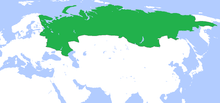
The Tsardom of Russia, c. 1700, reign of Peter the Great.
|
|
The Russian Empire formed from what was Tsardom of Russia under Peter the Great. Peter I, (1672–1725), played a major role in bringing his country into the European state system, and laid the foundations of a modern state in Russia. From its modest beginnings in the 14th century, Russia had become the largest state in the world by Peter's time. Three times the size of continental Europe, it spanned the Eurasian landmass from the Baltic Sea to the Pacific Ocean.
High modern historical and existing powers
- 19th, 20th, and 21st centuries
France
- 1815–1956
| French colonial empire |
|---|
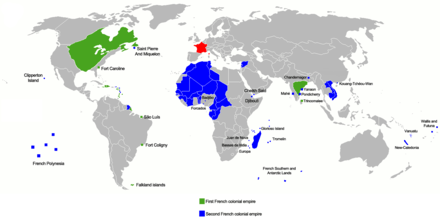
Map of the first (light green) and second (dark blue — plain and hachured) French colonial empires.
|

France was a dominant empire possessing many colonies in various locations around the world. The French colonial empire is the set of territories outside Europe that were under French rule primarily from the 17th century to the late 1960s (some see the French control of places such as New Caledonia as a continuation of that colonial empire). In the 19th and 20th centuries, the colonial empire of France was the second largest in the world behind the British Empire. The French colonial empire extended over 12,890,000 km2 (4,980,000 sq mi) of land at its height in the 1920s and 1930s. Including metropolitan France, the total amount of land under French sovereignty reached 13,500,000 km2 (5,200,000 sq mi) at the time, which is 8.7% of the Earth's total land area.
France began to establish colonies in North America, the Caribbean and India, following Spanish and Portuguese successes during the Age of Discovery, in rivalry with Britain for supremacy. A series of wars with Britain during the 18th and early 19th centuries which France lost ended its colonial ambitions on these continents, and with it is what some historians term the "first" French colonial empire. In the 19th century, France established a new empire in Africa and South East Asia. Some of these colonies lasted beyond the Second World War.
Second British Empire
- 1815–1956
| British Empire |
|---|

Anachronous map showing British Empire from 1600–present. By 1920 it had become the largest empire in history, constituting approximately 25% of the world's surface and 25% of the world's people.[36]
|
|
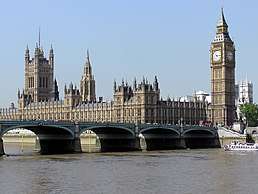
The British Empire was the largest empire in world history. During the 19th century the United Kingdom was the first country in the world to industrialise and embrace free trade, giving birth to the Industrial Revolution. The rapid industrial growth after the conquests of the wealthy Mughal Bengal, transformed Great Britain into the world's largest industrial and financial power, while the world's largest navy gave it undisputed control of the seas and international trade routes, an advantage which helped the British Empire, after a mid-century liberal reaction against empire-building, to grow faster than ever before. The Victorian empire colonised large parts of Africa, including such territories as South Africa, Egypt, Kenya, Sudan, Nigeria, and Ghana, most of Oceania, colonies in the Far East, such as Singapore, Malaysia, and Hong Kong, and took control over the whole Indian subcontinent, making it the largest empire in the world.[37]
After victory in the First World War, the Empire gained control of territories such as Tanzania and Namibia from the German Empire, and Iraq and Palestine (including the Transjordan) from the Ottoman Empire. By this point in 1920 the British empire had grown to become the largest empire in history, controlling approximately 25% of the world's land surface and 25% of the world's population.[36] It covered about 36.6 million km² (14.2 million square miles). Because of its magnitude, it was often referred to as the empire on which the sun never sets.[38]
The political and social changes and economic disruption in the United Kingdom and throughout the world caused by First World War followed only two decades later by the Second World War caused the Empire to gradually break up as colonies were given independence. Much of the reason the Empire ceased was because many colonies by the mid-20th century were no longer as undeveloped as at the arrival of British control nor as dependent and social changes throughout the world during the first half of the 20th century gave rise to national identity. The British Government, reeling from the economic cost of two successive world wars and changing social attitudes towards empire, felt it could no longer afford to maintain it if the country were to recover economically, pay for the newly created welfare state, and fight the newly emerged Cold War with the Soviet Union.
The influence and power of the British Empire dropped dramatically after the Second World War, especially after the Partition of India in 1947 and the Suez Crisis in 1956. The Commonwealth of Nations is the successor to the Empire, where the United Kingdom is an equal member with all other states.
Late Spanish Empire
- 1815–1898
| Spanish Empire |
|---|
|
An anachronous map showing areas pertaining to the Spanish Empire at various times over a period exceeding 400 years.
|
|
After the Napoleonic period the Bourbon dynasty was restored in Spain and over the huge number of Spanish territories around the world. But the shock of the Peninsular War sparked declarations of independence in the Latin America controlled by Spain and by 1835 successive revolutions had signed the end of the Spanish rule over the majority of this countries. Spain retained fragments of its empire in the Caribbean (Cuba and Puerto Rico); Asia (Philippines); and Oceania (Guam, Micronesia, Palau, and Northern Marianas) until the Spanish–American War of 1898. Spanish participation in the Scramble for Africa was minimal: Spanish Morocco was held until 1956 and Spanish Guinea and the Spanish Sahara were held until 1968 and 1975 respectively. The Canary Islands, Ceuta, Melilla and the other Plazas de Soberanía on the northern African coast have remained part of Spain.
Austrian Empire (Austria-Hungary)
- 1804–1867 and 1867–1918
After the Napoleonic era, Austria was one of the main powers in Europe with great influence over Germany, Italy and Eastern Europe. During the second half of the 19th century Austria was not able to prevent the unification of Italy and of Germany by Prussia (excluding the also German Austria) and was also obliged to grant equal partnership in the empire to Hungary. Nonetheless the empire remained one of the major players in European affairs until its destruction after the First World War.
Prussia and Germany
- 1815–1871, 1871–1918 and 1933–1945
| German Empire |
|---|
|
German colonies in 1914.
|
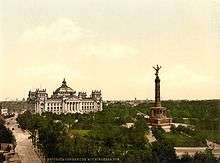
The Kingdom of Prussia dominated northern Germany politically, economically, and in terms of population, and was the core of the unified North German Confederation formed in 1867, which became part of the German Empire or Deutsches Reich in 1871 when the southern German states, excluding Austria, were added. Prussia attained its greatest importance in the 18th and 19th centuries. During the 19th century, Chancellor Otto von Bismarck pursued a policy of uniting the German principalities into a "Lesser Germany" which would exclude the Austrian Empire.
Germany rose again in world power status during the Third Reich (or Nazi Germany) under the dictatorship of Adolf Hitler between 1933 and 1945. It seized Austria and Czechoslovakia, and invaded Poland which launched World War II in Europe. In alliance with Italy and smaller Axis powers, Germany conquered most of Europe by 1940. Following the German invasion of the Soviet Union in 1941, the tide turned against the Third Reich as it suffered major military defeats in 1943; Germany was fully defeated by 1945.
Late Ottoman Empire
- 1815–1923
_bridge%2C_Constantinople%2C_Turkey-LCCN2001699426.tif.jpg)
| Ottoman Empire |
|---|
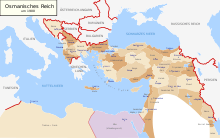
Ottoman territories in 1900 (See: list of territories).
|
|
The Ottoman Empire during the 19th century was still a considerable power, with a great extension of territories over Europe, Asia and Africa; but the empire was in a condition of decline and during this period lost progressively its influence, and the majority of his territories were conquered by other powers. The empire ended after the Turkish War of Independence in 1923 when the Republic of Turkey was proclaimed.
Russian Empire and Soviet Union
- 1815–1917 and 1917–1991

| Russian Empire |
|---|
.svg.png)
Russian Empire (green) as of 1866, at the time of the maximum territorial expansion of the empire.[39]
|
.svg.png)
The Soviet Union.
|
|
The Russian Empire as a state, existed from 1721 until it was declared a republic 1 September 1917. The Russian Empire was the successor to the Tsardom of Russia and the predecessor of the Soviet Union. It was one of the largest empires in world history, surpassed in landmass only by the British and Mongolian empires: at one point in 1866, it stretched from Northern Europe across Asia and into North America.
At the beginning of the 19th century the Russian Empire extended from the Arctic Ocean in the north to the Black Sea on the south, from the Baltic Sea on the west to the Pacific Ocean on the east. With 125.6 million subjects registered by the 1897 census, it had the third largest population of the world at the time, after Qing China and the British Empire. Like all empires it represented a large disparity in economic, ethnic, and religious positions. Its government, ruled by the Emperor, was one of the last absolute monarchies in Europe. Prior to the outbreak of World War I in August 1914 Russia was one of the five major Great Powers of Europe. After the October revolution it was transformed into the Soviet Union.[40]
Following the death of the first Soviet leader, Vladimir Lenin, in 1924, Joseph Stalin eventually won a power struggle and led the country through a large-scale industrialization with a command economy and political repression. In World War II, in June 1941, Germany and its allies invaded the Soviet Union, a country with which it had signed a non-aggression pact. After four years of brutal warfare, the Soviet Union emerged victorious as one of the world's two superpowers, the other being the United States.
The Soviet Union and its Eastern European satellite states engaged in the Cold War, a prolonged global ideological and political struggle against the United States and its Western Bloc allies, which it ultimately lost in the face of economic troubles and both domestic and foreign political unrest. In the late 1980s, the last Soviet leader Mikhail Gorbachev tried to reform the state with his policies of perestroika and glasnost, but the Soviet Union collapsed and was formally dissolved in December 1991 after the abortive August coup attempt. The Russian Federation assumed its rights and obligations.
Italian Empire
| Italian Empire |
|---|
.svg.png) Every territory ever controlled by the Italian Empire as some point in time during World War II. Kingdom of Italy (dark green), Italian colonial empire (light green) and Italian occupied territories (grey). |
- 1871–1947
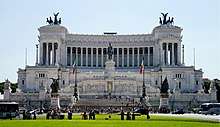
The Italian colonial empire was created after the Kingdom of Italy joined other European powers in establishing colonies overseas during the "scramble for Africa". Modern Italy as a unified state only existed from 1861. By this time France, Spain, Portugal, Britain, and the Netherlands, had already carved out large empires over several hundred years. One of the last remaining areas open to colonisation was on the African continent.[41][42]
By the outbreak of World War I in 1914, Italy had annexed Eritrea and Somalia, and had wrested control of portions of the Ottoman Empire, including Libya, though it was defeated in its attempt to conquer Ethiopia. The Fascist regime under Italian dictator Benito Mussolini which came to power in 1922 sought to increase the size of the empire further. Ethiopia was successfully taken, four decades after the previous failure, and Italy's European borders were expanded. An official "Italian Empire" was proclaimed on 9 May 1936 following the conquest of Ethiopia.[43]
Italy sided with Nazi Germany during World War II but Britain soon captured Italian overseas colonies. By the time Italy itself was invaded in 1943, its empire had ceased to exist. On 8 September 1943 the Fascist regime of Mussolini collapsed, and a Civil War broke out between Italian Social Republic and Italian Resistance Movement, supported by Allied forces.
Empire of Japan
- 1868–1945
| Empire of Japan |
|---|
.svg.png)
The Empire of Japan in 1942. The empire until 1905 is in dark green, acquisitions until 1930 are in lighter green, and occupied/conceded territories are in the lightest green.
|
The Empire of Japan, officially the Empire of Great Japan or simply Great Japan (Dai Nippon), was an empire that existed from the Meiji Restoration on 3 January 1868 to the enactment of the post-World War II Constitution of Japan on 3 May 1947.
Imperial Japan's rapid industrialization and militarization under the slogan Fukoku Kyōhei (富国強兵, "Enrich the Country, Strengthen the Army") led to its emergence as a great power, eventually culminating in its membership in the Axis alliance and the conquest of a large part of the Asia-Pacific region. At the height of its power in 1942, the Japanese Empire ruled over a land area spanning 7,400,000 square kilometres (2,857,000 sq mi), making it one of the largest maritime empires in history.
After winning wars against China (First Sino-Japanese War, 1894–95) and Russia (Russo-Japanese War, 1904–05) the Japanese Empire was considered to be one of the major powers worldwide. The maximum extent of the empire was gained during Second World War, when Japan conquered many Asian and Pacific countries (see Greater East Asian Co-Prosperity Sphere).
After suffering many defeats and the atomic bombings of Hiroshima and Nagasaki, however, the Empire of Japan surrendered to the Allies on 2 September 1945. A period of occupation by the Allies followed the surrender, and a new constitution was created with American involvement. The constitution came into force on 3 May 1947, officially dissolving the Empire. American occupation and reconstruction of the country continued well into the 1950s, eventually forming the current nation-state whose title is simply that ("the nation of Japan" Nippon-koku) or just "Japan".
United States
- 1900–present
| United States of America |
|---|
.svg.png)
United States territory.
|
Founded in 1776 by thirteen coastal colonies that declared their independence from Great Britain, the United States began its westward expansion following the end of the American Revolutionary War and the recognition of U.S. sovereignty in the 1783 Treaty of Paris. The treaty bequeathed to the nascent republic all land between the Appalachian Mountains and the Mississippi River, and Americans began migrating there in large numbers at the end of the 18th Century, resulting in the displacement of Native American cultures, often through native peoples' forcible deportation and violent wars of eviction. These efforts at expansion were greatly strengthened by the 1787 Constitutional Convention, which resulted in the ratification of the United States Constitution and transformed the U.S. from a loose confederation of semi-autonomous states into a federal entity with a strong national core. In 1803, the United States acquired Louisiana from France, doubling the country's size and extending its borders to the Rocky Mountains.
American population and power grew rapidly, so that by 1823 President James Monroe felt confident enough to issue his Monroe Doctrine, which proclaimed the Americas as the express sphere of the United States and, working in agreement with Great Britain, threatened military action against any European power that attempted to make advances in the area. This was the beginning of the U.S.'s emergence as a regional power in North America. That process was confirmed in the Mexican–American War of 1846–1848, in which the United States, following a skirmish between Mexican and U.S. forces in land disputed between Mexico and the U.S., invaded Mexico. The war, which included the deployment of U.S. forces into Mexico, the taking of Veracruz by sea, and the occupation of Mexico City by American troops (which finally resulted in Mexico's defeat), stunned much of the world. In the peace treaty (Treaty of Guadelupe Hidalgo) that followed, the U.S. annexed the northern half of Mexico, comprising what is now the Southwestern United States. During the course of the war, the United States also negotiated by treaty the acquisition of the Oregon Territory's southern half from Great Britain.
In 1867, William H. Seward, the U.S. Secretary of State, negotiated the purchase of Alaska from the Russian Empire. The United States defeated Spain in the Spanish–American War in 1898, and gained the possessions of Cuba, Puerto Rico, and the Philippines. The territory of Hawaii was annexed in 1898. By the early 20th century, the United States would come to be considered a great power,[44] marked by its participation in the Boxer Rebellion outside of the Americas region, as well as for Woodrow Wilson's participation in the Paris Peace Conference of 1919,[45] the first international trip by a U.S. President outside of the Americas.
The United States later participated in World War II, becoming a global power after it helped to secure victory for the allies in 1945; its vast economic and military resources including a short-lived period of monopoly on nuclear weapons made the U.S. one of the world's three remaining superpowers along with the USSR and the British Empire. After the deconstruction of the British Empire in the latter half of the 20th century (a process termed decolonization), the United States vied against the Soviet Union as one of the two remaining superpowers in the world in the Cold War. Upon the collapse of the Soviet Union in 1991, it became the sole superpower in the world, sometimes referred to as a hyperpower.
Russia and China
In a 2018 national defense strategy document, the United States government described Russia and China as “revisionist powers” that “seek to create a world consistent with their authoritarian models.”[46]
India
Consideration of Republic of India as a great power is very recent as compared to contemporary great powers, given its expanding economic and military circles. There is no collective agreement among observers for the status of India. However, all scholars believe that India is a great power or emerging as so. It maintains one of the largest armed forces and military budgets in the world.[47] Although India maintains its position as a major economic and military power, it is not a permanent member of the United Nations Security Council.[48][49][50][51][52]
Timeline
A timeline of the main great powers since the early 19th century:
See also
- Concert of Europe, after 1814
- Diplomatic history of World War I
- Diplomatic history of World War II
- European balance of power
- Foreign policy of the Russian Empire
- Great Eastern Crisis, 1875-1878
- Historic recurrence
- Historiography of the British Empire
- History of colonialism
- History of French foreign relations
- History of German foreign policy
- History of globalisation
- International relations, 1648–1814
- International relations (1919–1939)
- International relations of the Great Powers (1814–1919)
- List of ancient great powers
- List of largest empires
- List of medieval great powers
- Middle power
- New Imperialism
- Power (international relations)
- Timeline of imperialism
- Timeline of United States diplomatic history
Notes
- For Austria in 1815, see: [53][54][55]
- For Austria in 1880, see: [56]
- For Austria in 1900, see: [57]
- For the United Kingdom in 1815, see: [53][54][55]
- For the United Kingdom in 1880, see: [56]
- For the United Kingdom in 1990, see: [57]
- For the United Kingdom in 1919, see: [58]
- After the Statute of Westminster came into effect in 1931, the United Kingdom no longer represented the British Empire in world affairs.
- For the United Kingdom in 1938, see: [nb 8][59]
- For the United Kingdom in 1946, see: [53][60][61]
- For the United Kingdom in 2000, see: [62][63][60][53][64][65][66][67][68][69]
- For China in 1946, see: [53][60]
- For China in 2000, see: [53][60][63][67][70][71]
- For France in 1815, see: [53][54][55]
- For France in 1880, see: [56]
- For France in 1900, see: [57]
- For France in 1919, see: [58]
- For France in 1938, see: [59]
- For France in 1946, see: [53][60]
- For France in 2000, see: [62][53][60][63][64][65][67]
- For Germany in 1815, see: [53][54][55]
- For Germany in 1880, see: [56]
- For Germany in 1900, see: [57]
- For Germany in 1938, see: [59]
- For Germany in 2000, see: [62][53][63][64][65][67]
- For Italy in 1880, see: [72][73][74][75]
- For Italy in 1900, see: [57]
- For Italy in 1919, see: [58]
- For Italy in 1938, see: [59]
- For Italy in 2000, see: [62][64][65][76] [77][78]
- For Japan in 1900, see: [57]
- "The Prime Minister of Canada (during the Treaty of Versailles) said that there were 'only three major powers left in the world the United States, Britain and Japan' ... (but) The Great Powers could not be consistent. At the instance of Britain, Japan's ally, they gave Japan five delegates to the Peace Conference, just like themselves, but in the Supreme Council the Japanese were generally ignored or treated as something of a joke." from MacMillan, Margaret (2003). Paris 1919. United States of America: Random House Trade. p. 306. ISBN 0-375-76052-0.
- For Japan in 1919, see: [58][nb 32]
- For Japan in 1938, see: [59]
- For Japan in 2000, see: [53][63][70][79][64][67]
- For Russia in 1815, see: [53][54][55]
- For Russia in 1880, see: [56]
- For Russia in 1900, see: [57]
- For Russia in 1938, see: [59]
- For Russia in 1946, see: [53][60][61]
- For Russia in 2000, see: [53][60][63][70][64][65][67]
- For the United States in 1900, see: [57]
- For the United States in 1919, see: [58]
- For the United States in 1938, see: [59]
- For the United States in 1946, see: [53][60][61]
- For the United States in 2000, see: [62][53][60][63][80][64][65][67]
References
- Webster, Charles K, Sir (ed), British Diplomacy 1813–1815: Selected Documents Dealing with the Reconciliation of Europe, G Bell (1931), p307.
- Toje, A. (2010). The European Union as a small power: After the post-Cold War. New York: Palgrave Macmillan.
- Edward Sylvester Ellis, Charles F. Horne (1906). The story of the greatest nations: from the dawn of history to the twentieth century : a comprehensive history founded upon the leading authorities, including a complete chronology of the world and a pronouncing vocabulary of each nation, Volume 1. F. R. Niglutsch.
- In Powell, T. (1888). Illustrated home book of the world's great nations: Being a geographical, historical and pictorial encyclopedia. Chicago: People's Pub. Co.
- Yonge, C. M. (1882). A pictorial history of the world's great nations: From the earliest dates to the present time. New York: S. Hess.
- Harrison, T., & J. Paul Getty Museum. (2009). The great empires of the ancient world. Los Angeles, Calif: J. Paul Getty Museum.
- The Islamic world in decline by Martin Sicker p.97
- Kaushik Roy, War, Culture and Society in Early Modern South Asia, 1740–1849, (Routledge, 2011), 77.
- Immanuel C. Y. Hsü, The rise of modern China (4th ed. 1990) online free to borrow
- Wolfgang Eberhard, A History of China (1948) pp 286=326 online
- Helen Chapin Metz. Iran, a Country study. 1989. University of Michigan, p. 313.
- Emory C. Bogle. Islam: Origin and Belief. University of Texas Press. 1989, p. 145.
- Stanford Jay Shaw. History of the Ottoman Empire. Cambridge University Press. 1977, p. 77.
- Andrew J. Newman, Safavid Iran: Rebirth of a Persian Empire, IB Tauris (March 30, 2006).
- The Sword of Persia: Nader Shah, from Tribal Warrior to Conquering Tyrant "Nader commanded the most powerful military force in Asia, if not the world"
- Modern Conflict in the Greater Middle East: A Country-by-Country Guide page : 84 "Under its great ruler and military leader Nader Shah (1736-1747), Persia was arguably the world's most powerful empire"
- Royal Netherlands Navy Archived 11 May 2013 at the Wayback Machine
- Brendan Simms, Three Victories and a Defeat: The Rise and Fall of the First British Empire (2008).
- Nigel Dalziel, The Penguin Historical Atlas of the British Empire (2006),
- Wilbur, Marguerite Eyer; Company, The East India. The East India Company: And the British Empire in the Far East. Stanford University Press. p. 175. ISBN 9780804728645. Retrieved 17 June 2014.
- "The Mughal Empire". Retrieved 5 October 2014.
- The Islamic World to 1600: Rise of the Great Islamic Empires (The Mughal Empire) Archived 27 September 2011 at the Wayback Machine
- Maddison, Angus (2003): Development Centre Studies The World Economy Historical Statistics: Historical Statistics, OECD Publishing, ISBN 9264104143, pages 259–261
- Giorgio Riello, Tirthankar Roy (2009). How India Clothed the World: The World of South Asian Textiles, 1500-1850. Brill Publishers. p. 174. ISBN 9789047429975.
- Ishat Pandey (2017). The Sketch of The Mughal Empire. Lulu Publishers. ISBN 9780359221202.
- Sanjay Subrahmanyam (1998). Money and the Market in India, 1100–1700. Oxford University Press. ISBN 9780521257589.
- Abhay Kumar Singh (2006). Modern World System and Indian Proto-industrialization: Bengal 1650-1800, (Volume 1). Northern Book Centre. ISBN 9788172112011.
- Caroline Finkel, Osman's Dream: The Story of the Ottoman Empire, 1300–1923.
- H. Inaicik "The rise of the Ottoman Empire" in P.M. Holt, A.K. S. Lambstone, and B. Lewis (eds), The Cambridge History of Islam (2005).(Cambridge University). pages 295–200
-
- Alan Palmer, The Decline and Fall of the Ottoman Empire. (1992)
- Heritage: Interactive Atlas: Polish-Lithuanian Commonwealth, last accessed on 19 March 2006 At its apogee, the Polish-Lithuanian Commonwealth comprised some 400,000 square miles (1,000,000 km2) and a multi-ethnic population of 11 million. For population comparisons, see also those maps: "Archived copy". Archived from the original on 17 February 2013. Retrieved 18 June 2017.CS1 maint: archived copy as title (link), "Archived copy". Archived from the original on 17 February 2013. Retrieved 18 June 2017.CS1 maint: archived copy as title (link).
- (in English) David Sneath (2007). The headless state: aristocratic orders, kinship society, & misrepresentations of nomadic inner Asia. New York: Columbia University Press. p. 188. ISBN 978-0-231-14054-6.
- (in English) M. L. Bush (1988). Rich noble, poor noble. Manchester University Press ND. pp. 8–9. ISBN 0-7190-2381-5.
- Derek Mckay; H.M. Scott (1983). The Rise of the Great Powers 1648 - 1815. Pearson. pp. 10–14. ISBN 9781317872849.
- Kekke Stadin, "The masculine image of a great power: Representations of Swedish imperial power c. 1630–1690." Scandinavian journal of history 30.1 (2005): 61-82.
- Angus Maddison. The World Economy: A Millennial Perspective (p. 98, 242). OECD, Paris, 2001.
- Timothy H. Parsons, The British Imperial Century, 1815–1914: A World History Perspective (2nd ed. 2019)
- Timothy H. Parsons, The Second British Empire (2014)
- After 1866, Alaska was sold and South Sakhalin lost to Japan, but Batum, Kars, Pamir, and the Transcaspian region (Turkmenistan) were acquired. The map incorrectly shows Tuva in dark green, although in reality protectorate over Tuva was only established in 1914.
- Iver B. Neumann, "Russia as a great power, 1815–2007." Journal of International Relations and Development 11.2 (2008): 128-151. online
- Giuseppe Finaldi, A History of Italian Colonialism, 1860–1907: Europe’s Last Empire (Routledge, 2016).
- Angelo Del Boca, "The myths, suppressions, denials, and defaults of Italian colonialism." in Patrizia Palumbo, ed. A place in the sun: Africa in Italian colonial culture from post-unification to the present (2003): 17-36.
- Lowe, p.289
- Dallin, David (November 2006). The Rise of Russia in Asia. ISBN 9781406729191.
- MacMillan, Margaret (2003). Paris 1919. United States of America: Random House Trade. pp. 36, 306, 431. ISBN 0-375-76052-0.
- Ali, Idrees (19 January 2018). "U.S. military puts 'great power competition' at heart of strategy: Mattis". Reuters. Retrieved 20 January 2018.
- Zbigniew Brzezinski (24 January 2012). Strategic Vision: America & the Crisis of Global Power. Basic Books. ISBN 9780465029549.
- Buzan, Barry (2004). The United States and the Great Powers. Cambridge, United Kingdom: Polity Press. p. 71. ISBN 978-0-7456-3375-6.
- Buzan & Wæver, Regions and Powers (2003, p. 55)
- Perkovich, George. "Is India a Major Power?" (PDF). The Washington Quarterly (27.1 Winter 2003–04). Archived from the original (PDF) on 27 February 2008. Retrieved 13 December 2007.
- Encarta - Great Powers Archived 2009-11-01 at WebCite
- Dilip Mohite (Spring 1993). "Swords and Ploughshares- India: The Fourth Great Power?". Vol. 7, No. 3. Arms Control, Disarmament, and International Security (ACDIS). Archived from the original on 1 September 2006. Retrieved 13 December 2007.
- Peter Howard (2008). "Great Powers". Encarta. MSN. Archived from the original on 31 October 2009. Retrieved 20 December 2008.
- Fueter, Eduard (1922). World history, 1815–1920. United States of America: Harcourt, Brace and Company. pp. 25–28, 36–44. ISBN 1584770775.
- Danilovic, Vesna. "When the Stakes Are High—Deterrence and Conflict among Major Powers", University of Michigan Press (2002), pp 27, 225–228 (PDF chapter downloads) (PDF copy).
- McCarthy, Justin (1880). A History of Our Own Times, from 1880 to the Diamond Jubilee. New York, United States of America: Harper & Brothers, Publishers. pp. 475–476.
- Dallin, David (November 2006). The Rise of Russia in Asia. ISBN 9781406729191.
- MacMillan, Margaret (2003). Paris 1919. United States of America: Random House Trade. pp. 36, 306, 431. ISBN 0-375-76052-0.
- Harrison, M (2000) The Economics of World War II: Six Great Powers in International Comparison, Cambridge University Press.
- Louden, Robert (2007). The world we want. United States of America: Oxford University Press US. p. 187. ISBN 978-0195321371.
- The Superpowers: The United States, Britain and the Soviet Union – Their Responsibility for Peace (1944), written by William T.R. Fox
- Canada Among Nations, 2004: Setting Priorities Straight. McGill-Queen's Press - MQUP. 17 January 2005. p. 85. ISBN 0773528369. Retrieved 13 June 2016. ("The United States is the sole world's superpower. France, Italy, Germany and the United Kingdom are great powers")
- T. V. Paul; James J. Wirtz; Michel Fortmann (2005). Balance of Power. United States of America: State University of New York Press, 2005. pp. 59, 282. ISBN 0791464016. Accordingly, the great powers after the Cold War are Britain, China, France, Germany, Japan, Russia, and the United States p.59
- Sterio, Milena (2013). The right to self-determination under international law : "selfistans", secession and the rule of the great powers. Milton Park, Abingdon, Oxon: Routledge. p. xii (preface). ISBN 978-0415668187. Retrieved 13 June 2016. ("The great powers are super-sovereign states: an exclusive club of the most powerful states economically, militarily, politically and strategically. These states include veto-wielding members of the United Nations Security Council (United States, United Kingdom, France, China, and Russia), as well as economic powerhouses such as Germany, Italy and Japan.")
- Transforming Military Power since the Cold War: Britain, France, and the United States, 1991–2012. Cambridge University Press. 2013. p. 224. ISBN 978-1107471498. Retrieved 13 June 2016. (During the Kosovo War (1998) "...Contact Group consisting of six great powers (the United states, Russia, France, Britain, Germany and Italy).")
- McCourt, David (28 May 2014). Britain and World Power Since 1945: Constructing a Nation's Role in International Politics. United States of America: University of Michigan Press. ISBN 978-0472072217.
- Baron, Joshua (22 January 2014). Great Power Peace and American Primacy: The Origins and Future of a New International Order. United States: Palgrave Macmillan. ISBN 978-1137299482.
- Chalmers, Malcolm (May 2015). "A Force for Order: Strategic Underpinnings of the Next NSS and SDSR" (PDF). Royal United Services Institute. Briefing Paper (SDSR 2015: Hard Choices Ahead): 2.
While no longer a superpower (a position it lost in the 1940s), the UK remains much more than a 'middle power'.
- Walker, William (22 September 2015). "Trident's Replacement and the Survival of the United Kingdom". International Institute for Strategic Studies, Global Politics and Strategy. 57 (5): 7–28. Retrieved 31 December 2015.
Trident as a pillar of the transatlantic relationship and symbol of the UK's desire to remain a great power with global reach.
- UW Press: Korea's Future and the Great Powers
- Yong Deng and Thomas G. Moore (2004) "China Views Globalization: Toward a New Great-Power Politics?" The Washington Quarterly
- Kennedy, Paul (1987). The Rise and Fall of the Great Powers. United States of America: Random House. p. 204. ISBN 0-394-54674-1.
- Best, Antony; Hanhimäki, Jussi; Maiolo, Joseph; Schulze, Kirsten (2008). International History of the Twentieth Century and Beyond. United States of America: Routledge. p. 9. ISBN 978-0415438964.
- Wight, Martin (2002). Power Politics. United Kingdom: Continuum International Publishing Group. p. 46. ISBN 0826461743.
- Waltz, Kenneth (1979). Theory of International Politics. United States of America: McGraw-Hill. p. 162. ISBN 0-07-554852-6.
- Why are Pivot States so Pivotal? The Role of Pivot States in Regional and Global Security. Netherlands: The Hague Centre for Strategic Studies. 2014. p. Table on page 10 (Great Power criteria). Archived from the original on 11 October 2016. Retrieved 14 June 2016.
- Italy: 150 years of a small great power, eurasia-rivista.org, 21 December 2010
- Kuper, Stephen. "Clarifying the nation's role strengthens the impact of a National Security Strategy 2019". Retrieved 22 January 2020.
Traditionally, great powers have been defined by their global reach and ability to direct the flow of international affairs. There are a number of recognised great powers within the context of contemporary international relations – with Great Britain, France, India and Russia recognised as nuclear capable great powers, while Germany, Italy and Japan are identified as conventional great powers
- Richard N. Haass, "Asia's overlooked Great Power", Project Syndicate April 20, 2007.
- "Analyzing American Power in the Post-Cold War Era". Retrieved 28 February 2007.
Further reading
- Banks, Arthur. (1988) A World Atlas of Military History 1861–1945
- Cambridge Modern History Atlas (1912) online free. 141 maps
- Catchpole, Brian. (1982) Map History of the Modern World
- Cooper, F. (2008). Empires and Political Imagination in World History. Princeton [u.a.]: Princeton University Press.
- Daniels, Patricia S. and Stephen G. Hyslop, Almanac of World History (3rd ed 2014); 384pp well illustrated
- Doyle, M. W. (1986). Empires. Ithaca, N.Y: Cornell University Press.
- Farrington, K. (2003). Historical Atlas of Empires. London: Mercury.
- Grenville, J.A.S. (1994) A History of the World in the Twentieth Century (1994). online free
- Haywood, John. (1997) Atlas of world history online free
- Kinder, Hermann and Werner Hilgemann. The Penguin Atlas of World History (2 vol, 2004); advanced topical atlas. excerpt of vol 1 also see excerpt vol 2
- Langer, William, ed. (1973) An Encyclopedia Of World History (1948 And later editions) online free
- Stearns, Peter, ed. The Encyclopedia of World History (2007), 1245pp; update of Langer
- Mckay, Derek, and H.M. Scott (1983). The Rise of the Great Powers 1648 - 1815. Pearson. ISBN 9781317872849.CS1 maint: multiple names: authors list (link)
- Pella, John & Erik Ringmar, (2019) History of international relations Online free
- O'Brian, Patrick K. Atlas of World History (2007) Online free
- Rand McNally Atlas of World History (1983), maps #76-81. Published in Britain as the Hamlyn Historical Atlas online free
- Roberts, J. M. and Odd Arne Westad, eds. The Penguin History of the World (6th ed. 2014) 1280pp excerpt
- Robertson, Charles Grant. An historical atlas of modern Europe from 1789 to 1922 with an historical and explanatory text (1922) online free

